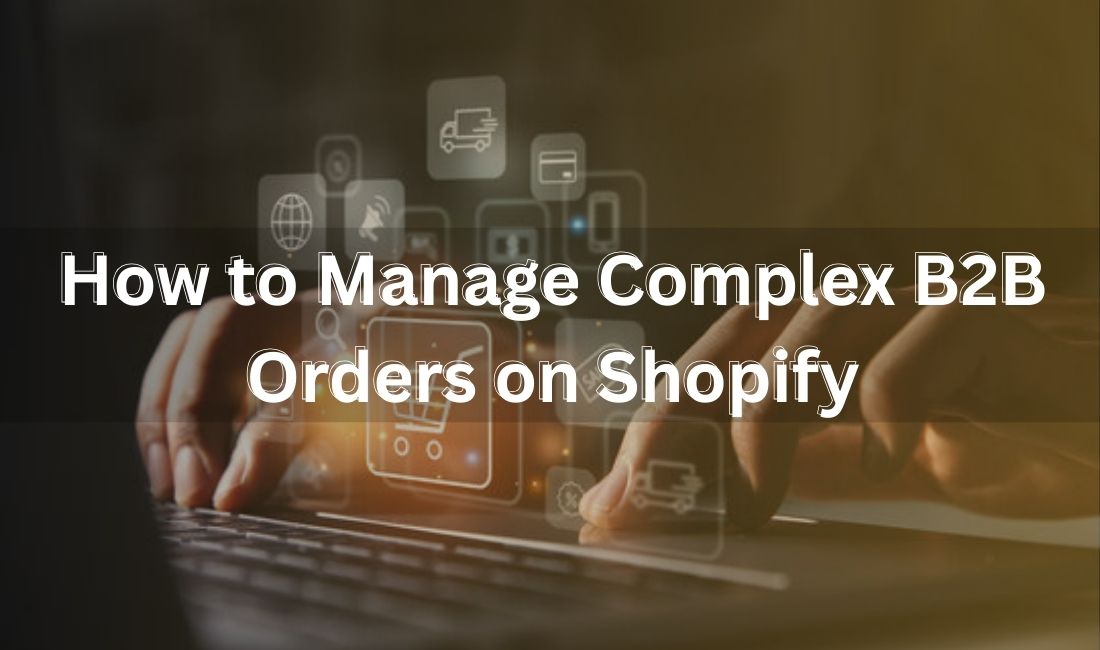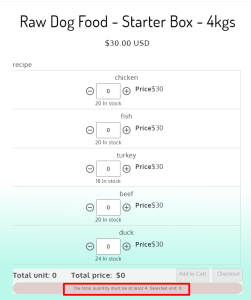
Handling complex B2B orders on Shopify can be tricky. Unlike regular online orders, B2B transactions often involve bulk purchases, special pricing, flexible payment terms, and complex shipping needs. Without the right tools, it can be hard to manage these orders efficiently and keep customers happy.
Luckily, Shopify is a great platform for B2B transactions. It offers features like custom pricing, order management, and easy integrations that help you streamline the B2B process.
In this article, we’ll explore how to handle complex B2B orders on Shopify. By the end, you’ll have a clear roadmap to optimizing your Shopify store for B2B transactions, ensuring efficiency, scalability, and customer satisfaction. Let’s get started!
Table of Contents
Understanding Complex B2B Orders
Managing B2B orders comes with its own set of challenges that differ from regular e-commerce transactions. For starters, B2B merchants often deal with large order volumes, which can overwhelm basic order management systems. Handling bulk purchases means tracking inventory accurately, ensuring enough stock is available, and preparing for potential back orders.
Another pain point is pricing variations. Unlike standard retail, B2B transactions usually involve customized pricing based on customer agreements, order size, or long-term contracts. This makes applying consistent pricing rules tricky, and manual updates can lead to errors.
Lastly, there’s the challenge of fulfillment logistics. Fulfilling large orders quickly and accurately requires a well-organized supply chain. Missed deadlines or incorrect shipments can harm business relationships.
To scale your B2B sales effectively, you need a structured approach. Simplified processes for pricing, order management, and fulfillment are key to offering a smooth, error-free experience for your clients.
Implementing Customer-Specific Pricing & Discounts
In B2B sales, one-size-fits-all pricing doesn’t work. Different customers have different needs, and offering customer-specific pricing is key to securing long-term relationships. You can easily set up tiered pricing, volume discounts, corporate discount programs, and exclusive deals for specific customers with wholesale apps from the Shopify App Store.
To streamline this, consider automating discounts based on order quantity, customer tags, or negotiated contracts. You can apply pre-set rules to apply price reductions based on order size, customer tags, or purchase frequency.
When negotiating prices, transparency is key. Offer clear pricing tiers, set minimum order quantities, and provide incentives like bulk discounts or free shipping. Automating these discounts ensures consistency while making it easier for customers to reorder.
By setting up personalized pricing structures, you create a frictionless buying experience, boosting sales while keeping your B2B clients happy.
Organizing Customers & Controlling Access
When you’re dealing with B2B orders on Shopify, treating every customer the same just doesn’t cut it. You’re not selling to one type of buyer—you’re working with resellers, distributors, wholesalers, and maybe even bulk corporate clients. That’s why organizing your customers into clear segments is key to running things smoothly.
Start by tagging and segmenting customers based on who they are and what they need. For example, you can group wholesale buyers under one tag and give resellers or VIP distributors their own. This makes it way easier to manage pricing, discounts, and even the types of products each group sees. It’s like giving everyone a personalized storefront without the hassle.
Now, what about keeping your exclusive B2B prices and products hidden from regular retail shoppers? You can use Shopify’s built-in B2B features or apps that let you restrict access to certain pages, collections, or pricing—only showing them to approved customers who are logged in. So your wholesale pricing stays private, and your retail customers won’t get confused or undercut your margins.
Handling Large Orders Efficiently
B2B customers don’t just add a couple of items to their cart and bounce. They’re placing large, complex B2B orders that can easily overwhelm your store if you’re not set up for it. That’s why having systems in place to manage high-volume orders without errors or delays is a must.
First, make bulk buying easy. You can simplify the process using bulk order forms or even allow customers to upload CSV files with their order details. This saves them time and reduces your risk of input mistakes. No one wants to add 100 variants manually!
Next up: store performance. Big orders can mean heavy data loads, and if your site slows down or crashes at checkout, you’ll lose that sale fast. Optimize your store by minimizing unnecessary apps, compressing images, and using a fast, lightweight theme built for high-traffic and high-cart-value customers.
And don’t forget the rules of the game. Set minimum order quantities, order limits, product and variant restrictions, and custom checkout logic to keep orders aligned with your B2B policies. For example, you can require a minimum purchase of 50 units or restrict checkout if SKUs are mixed incorrectly. You can use bulk order apps from the Shopify App Store to handle complex B2B orders.

With the right setup, you can make sure your store handles large B2B orders like a pro—no slowdowns, no errors, just smooth transactions.
Offering Flexible Payment Methods & Terms
B2B buyers expect more than just credit card checkout. Think Net 30/60 terms, wire transfers, ACH, purchase orders, and yes—cards too. The more flexible your payment options, the easier it is to close big deals.
Shopify supports invoicing and custom payment terms, and you can level up with integrations to automate your billing and reduce manual work.
To keep your cash flow healthy, set clear policies: offer early payment discounts, send automated reminders, and require deposits on large orders. Flexible payment options + smart policies = faster payments and smoother operations.
Optimizing Order Fulfillment & Inventory Management
Fulfilling complex B2B orders—especially across multiple locations—can get messy fast. Delays, split shipments, and overselling are common challenges without strong inventory management in place. That’s where third-party logistics (3PL) comes in. Partnering with a reliable 3PL lets you outsource warehousing and fulfillment while still syncing everything with your Shopify store. Most top 3PLs integrate seamlessly, so you can track orders, shipping, and returns in one place.
To avoid stock-outs or double-selling, use real-time inventory tracking. This gives you an up-to-date view of what’s in stock and where, even across different warehouses. Smart inventory management means fewer fulfillment errors, faster shipping, and happier wholesale customers. Whether you fulfill in-house or through 3PL, having a system that updates instantly is key to keeping your B2B operation smooth and scalable.
Managing Taxes & Compliance for B2B Transactions
B2B transactions often come with complex tax requirements, but Shopify makes it manageable. If you’re dealing with tax-exempt customers (like resellers), you can tag their accounts and set exemptions directly in Shopify, so taxes aren’t charged at checkout. For broader coverage, use Shopify’s built-in tax engine or third-party tools to automate tax calculations across regions—whether it’s VAT, GST, or sales tax.
Don’t overlook compliance, either. B2B buyers may require detailed invoices for record-keeping, especially for audits. Keeping your tax and invoicing processes clean ensures smoother transactions, builds trust, and protects your business from costly penalties.
Improving Customer Support & Account Management
Great support can make or break a B2B relationship. For high-value clients, consider assigning dedicated account managers who understand their unique needs, manage reorders, and offer tailored solutions—building long-term loyalty. But not everything needs to be manual. Offering self-service portals where customers can track orders, download invoices, or manage account details gives them more control and saves your team time.
B2B buyers also expect quick, reliable support across channels. Make sure your store offers multichannel support—live chat for instant answers, email for detailed queries, and phone for urgent issues. Efficient support paired with smart account management keeps clients happy and makes your business stand out in a competitive market.
Conclusion
Handling complex B2B orders on Shopify doesn’t have to be overwhelming. From segmenting customers and offering flexible payments to streamlining fulfillment and managing taxes—every step matters. As your business grows, continuously optimizing your operations is key to staying efficient and competitive. Start by identifying gaps in your current B2B setup, test solutions like bundling, automation, and 3PLs, and refine them based on customer feedback. Whether you’re just getting started or scaling fast, smart systems and thoughtful strategies will help you serve B2B clients better—and boost your bottom line. Ready to level up your B2B game? Take one step today, and build from there.
Complex B2B Order FAQ
What makes a B2B order complex compared to a regular B2C order?
B2B orders are typically larger in quantity, involve customized pricing or product specifications, and require more detailed documentation, such as purchase orders, invoices, and contracts. These orders often require coordination between multiple stakeholders and are subject to different payment terms and logistics arrangements.
How can I streamline the process of handling complex B2B bulk orders?
To streamline complex B2B orders, consider using automated systems for order tracking, invoicing, and payment processing. Implementing a robust B2B eCommerce platform can also simplify communication, ensuring all stakeholders are updated in real-time and minimizing errors.
What are the payment terms for complex B2B orders?
Payment terms for B2B orders can vary widely and often include options such as net 30, net 60, or even 90 days. These terms are typically negotiated between the buyer and supplier, depending on the order size, customer relationship, and creditworthiness.
